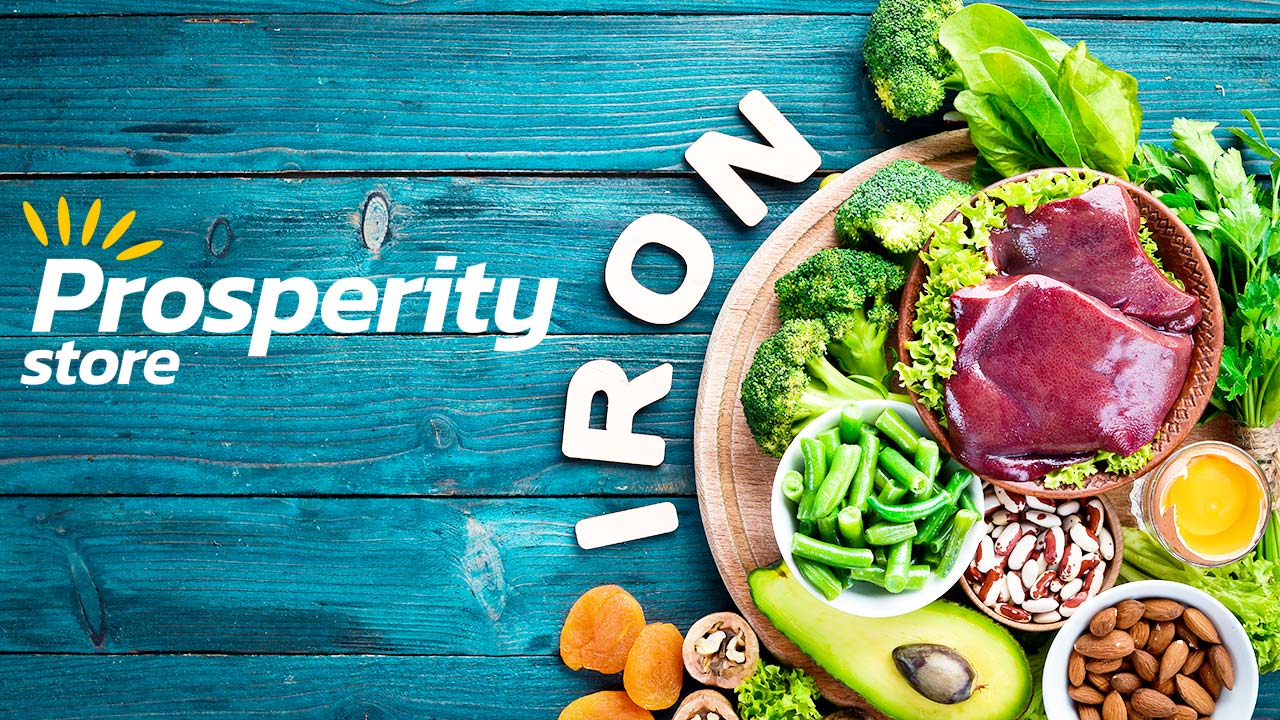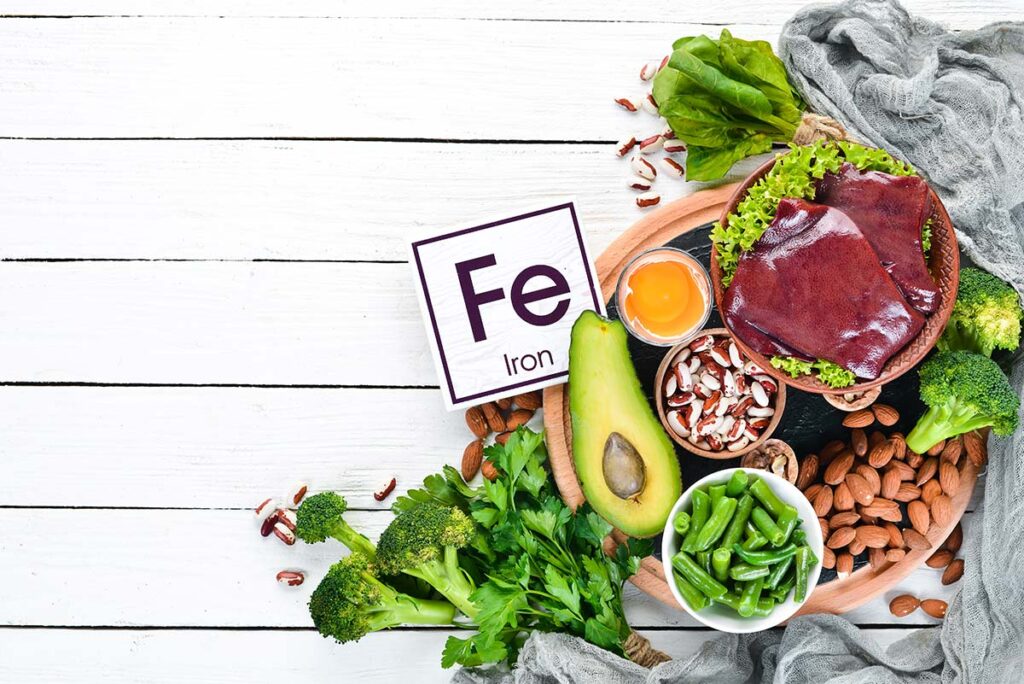Healthy Foods High in Iron
Summarize

Iron is an essential mineral the human body needs to stay healthy. It is involved in many biological processes, including oxygen transport and immune system functioning. Yet, iron deficiency is a common health issue. A survey of over 8,000 adults found that 14% have an iron deficiency, and 15% have a functional iron deficiency, meaning adequate iron is stored. Still, the body is unable to use it. This underscores the crucial role iron plays in our overall health, making it important to ensure we get enough of it in our diet.
What Is Iron?
“Iron is a mineral and an essential element of hemoglobin, an erythrocyte protein or type of red blood cell.”
The liver produces transferrin, a protein that binds to and carries iron ions from the intestines to bone marrow, where hemoglobin is made in red blood cells. Red blood cells bind to and transfer oxygen from the lungs to tissues throughout the body. Iron is also an element of myoglobin, red blood cells in muscle cells.
- Approximately 70% of the iron is found in hemoglobin and myoglobin.
- Approximately 6% of iron is a component of proteins involved in energy metabolism and respiration. Iron plays a crucial role in these processes by helping to transport oxygen to cells, where it is used to produce energy. It also contributes to proper immune function.
- Some portion of the 6% of iron also interacts with enzymes involved in synthesizing collagen and neurotransmitters.
- Approximately 25% of iron binds to and is stored in ferritin, a protein in cells, making iron available throughout the body.
Ferritin sequesters (isolates) free iron from cells to prevent its reaction with oxygen, leading to reactive oxygen species (ROS) produced by normal metabolism. ROS can cause oxidative stress and damage cells when their levels are too high. The highest ferritin concentrations are in the liver, bone marrow and spleen. A small amount of ferritin is in serum (blood). Stored iron is released as the body needs it.
How Much Iron Do I Need?
The amount of iron you need depends on your gender, age and diet. The National Institutes of Health recommends getting the following amounts of iron daily.
| Male | Female | |
| 0 – 6 months | .27 mg | .27 mg |
| 7-12 months | 11 mg | 11 mg |
| 1-3 years | 7 mg | 7 mg |
| 4-8 years | 10 mg | 10 mg |
| 9-13 years | 8 mg | 8 mg |
| 14-18 years | 11 mg | 15 mg |
| 19-50 years | 8 mg | 18 mg 27 mg while pregnant 10 mg while lactating |
| 51+ years | 8 mg | 8 mg |
These are recommended daily amounts, but the actual amount a person needs depends on various factors besides gender and age. These factors include overall health, dietary habits, and specific health conditions affecting iron absorption or utilization.
Diseases
Chronic diseases like rheumatoid arthritis, kidney disease and inflammatory bowel disease can lead to an iron deficiency.
Genetics
Some rare inherited conditions create an iron deficiency by blocking the intestines from absorbing iron and making it more difficult to stop bleeding.
Heavy menstrual bleeding
Excessive menstrual bleeding can cause a significant amount of blood loss.
Endurance sports
Athletes lose iron through the breakdown of red blood cells and the GI tract.
Internal bleeding
Medications, ulcers, colon cancer and gastrointestinal disorders can lead to blood loss.
Obesity
Being significantly overweight makes it difficult for your body to regulate iron.
Diet
A consistent diet low in iron-rich foods and lacking iron supplementation can lead to an iron deficiency.
Symptoms of Iron deficiency
Anemia is a blood disorder in which there are not enough healthy red blood cells or hemoglobin. This means your body is not getting enough oxygen-rich blood. There are as many as 3 million people who have anemia and 800,000 who visit emergency rooms annually with anemia as the primary diagnosis.
A recent survey found that 14% of participants had an absolute iron deficiency, a severe lack of stored iron, and 15% had a functional iron deficiency, in which adequate iron is stored. Still, it is not mobilized enough to support the body’s needs.
The symptoms of an iron deficiency include the following.
- Pale or sallow skin
- Lack of energy
- Rapid heartbeat
- Headache
- Generalized weakness
- Shortness of breath or chain pain when doing activities
- Smooth or sore tongue
- Pounding in the ears
- Craving for ice or clay
- Brittle nails or hair loss
- Problems concentrating
- Mouth ulcers
- Hair loss
- Uncontrolled leg movements
You may have early symptoms like dizziness or feeling tired more frequently but more severe symptoms as the anemia worsens. Absolute iron deficiency can be treated with iron supplements. Functional anemia requires treating the health condition that is causing low-stored iron.
Iron Rich Foods
There are two types of dietary iron: heme and nonheme. The heme iron is readily found in seafood, meat and poultry. Heme iron forms by combining iron with the precursor protoporphyrin IX, an organic compound. Heme iron contributes 10-15% of total iron consumption in western populations. Non-heme iron is mainly found in plant sources.

You can include many iron-rich foods in your diet to support heme and on-heme iron needs. What foods are high in iron? The best sources of iron include the following.
- Fortified breakfast cereals
- Oysters
- Sardines
- Canned tuna in water
- Beef liver
- Beef
- Chicken with skin
- Turkey
- Broccoli
- Chickpeas
- Lentils
- White beans
- Kidney beans
- Potato
- Spinach
- Green peas
- Tomatoes
- Raisins
- Tofu
- Hard-boiled egg
- White or brown rice
- Whole wheat spaghetti
- Bread
- Dark chocolate
- Cashew nuts
- Pistachio nuts
To increase iron absorption, you can eat food with iron for adults, like bell peppers, citrus fruits and tomatoes.
FAQs
Are plant sources of iron as good as animal sources?
Animal sources (meat, poultry, seafood) are the best food for an iron deficiency because they contain heme iron, which is easily absorbed in the body. Plant sources provide more non-heme iron, which is less readily absorbed. However, a well-balanced diet that includes both types of iron daily is key to maintaining a healthy iron level and overall well-being.
Can I have too much iron?
It is possible to have too much iron, which may be harmful. Too much iron can lead to an upset stomach, nausea, constipation, abdominal pain, diarrhea and vomiting. Taking too much iron can also lead to stomach lining inflammation and ulcers and decrease zinc absorption. Taking extremely high doses of iron, like iron supplements, can cause organ failure, convulsions and coma.
Who might be low on iron?
People who might be low on iron include menstruating or pregnant women and people with certain health conditions like gastrointestinal disorders or heart failure. Children are also at risk of low iron. However, a poor diet at any age can lead to low iron due to mainly eating foods with a low iron content. Drinking too much cow’s milk increases the risk of an iron deficiency. Cow’s milk has low iron content, and casein and calcium can prevent iron absorption from other foods.
How can I raise my iron levels quickly?
Taking an iron supplement can be the best way to increase your iron levels quickly. Sometimes, a doctor will order an iron infusion if iron levels are extremely low. You should also amend your diet and include more iron-rich foods, like meat, liver, seafood, fortified cereals and vegetables high in iron, like spinach, daily. Drinking vitamin C may aid iron absorption, especially non-heme iron. It converts ferric iron to ferrous iron, which is more soluble.
Maintain Your Iron Balance
It is important not to ignore symptoms like unexplained fatigue or sallow skin and to talk to your doctor. An iron deficiency is easily identified through a blood test. An iron profile can measure ferritin, serum iron and iron-binding capacity. Most cases of low iron are easily corrected through diet and iron supplementation. Additional tests can be performed if a doctor suspects underlying medical issues affect iron levels.
Sources
- https://jamanetwork.com/journals/jamanetworkopen/article-abstract/2823909
- https://www.ucsfhealth.org/education/hemoglobin-and-functions-of-iron
- https://www.sciencedirect.com/topics/neuroscience/reactive-oxygen-species
- https://pmc.ncbi.nlm.nih.gov/articles/PMC2516548/
- https://www.nhlbi.nih.gov/health/anemia/iron-deficiency-anemia
- https://www.cdc.gov/nchs/fastats/anemia.htm
- https://jamanetwork.com/journals/jamanetworkopen/article-abstract/2823909
- https://www.hematology.org/education/patients/anemia/iron-deficiency and https://www.mountsinai.org/health-library/diseases-conditions/iron-deficiency-anemia
- https://ods.od.nih.gov/factsheets/Iron-HealthProfessional/
- https://www.ncbi.nlm.nih.gov/books/NBK540969/
- https://ods.od.nih.gov/factsheets/Iron-Consumer/#h11
Share this post
